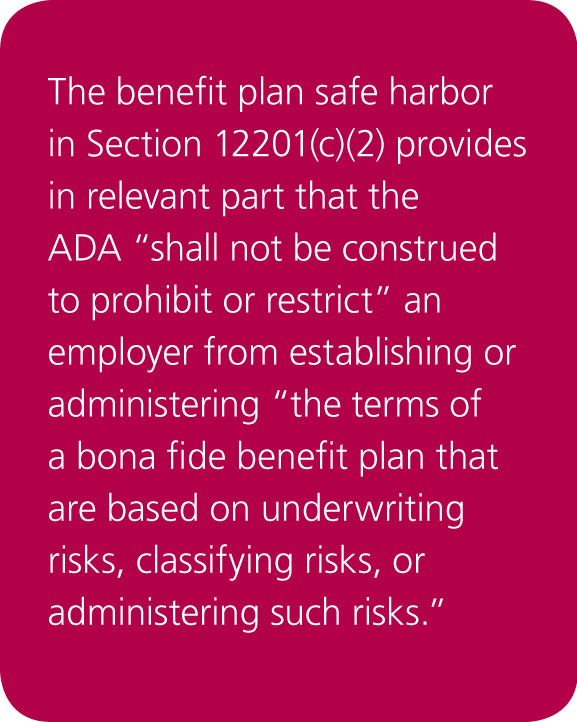Legal Update
Jan 11, 2016
Another Judge Puts the Brakes on EEOC Wellness Plan Overreach
We have commented recently that there are questions about the authority of the EEOC to issue its proposed wellness regulations that claim authority under the Americans with Disabilities Act (ADA) (see http://www.seyfarth.com/publications/MA041715-EB). The courts have been skeptical of EEOC claims of authority to issue those regulations, and, just before the New Year, Judge Crabb of the U.S. District Court for the Western District of Wisconsin added her voice to those who think the EEOC is overreaching.
The new decision arises out of EEOC v. Flambeau, Inc., No. 14-cv-638 (W.D. Wis. Dec. 30, 2015). The EEOC, or at least the Chicago office of the EEOC, argued that Flambeau, Inc. violated the ADA section found at 42 U.S.C. § 12112(d)(4)(A) by conditioning participation in an employer-subsidized self-funded health plan on completion of a “health risk assessment” and “biometric screening test.” The health risk assessment “required each participant to complete a questionnaire about his or her medical history, diet, mental and social health and job satisfaction.” The biometric test “involved height and weight measurements, a blood pressure test and a blood draw.”
 Judge Barbara Crabb summarily rejected the EEOC’s reliance on § 12112(d)(4)(A). That section prohibits medical examinations and/or inquiries that are not job-related and consistent with business necessity. The judge gave the EEOC the benefit of the doubt under §12112(d)(4)(A), but still found agency overreach. The judge said that the ADA benefit plan safe harbor in § 12201(c)(2) trumps any reliance on § 12112(d)(4)(A) as long as the wellness provisions are terms of an employer health plan and are used to help the employer administer and underwrite insurance risks. (The judge stated that the safe harbor may not apply to a stand-alone wellness program.) Judge Crabb relied on statements of the employer’s consultants that they used the employer wellness data to classify health risks, to project health plan costs, and to decide the participants’ cost of coverage for the year. That the wellness terms were not set forth in a summary plan description or collective bargaining agreement was not dispositive. Judge Crabb also said that the ADA’s “subterfuge” exception to the ADA benefit plan safe harbor was not triggered because the EEOC offered no evidence that the employer’s wellness terms were used to discriminate against any employee in a non-benefit plan aspect of employment.
Judge Barbara Crabb summarily rejected the EEOC’s reliance on § 12112(d)(4)(A). That section prohibits medical examinations and/or inquiries that are not job-related and consistent with business necessity. The judge gave the EEOC the benefit of the doubt under §12112(d)(4)(A), but still found agency overreach. The judge said that the ADA benefit plan safe harbor in § 12201(c)(2) trumps any reliance on § 12112(d)(4)(A) as long as the wellness provisions are terms of an employer health plan and are used to help the employer administer and underwrite insurance risks. (The judge stated that the safe harbor may not apply to a stand-alone wellness program.) Judge Crabb relied on statements of the employer’s consultants that they used the employer wellness data to classify health risks, to project health plan costs, and to decide the participants’ cost of coverage for the year. That the wellness terms were not set forth in a summary plan description or collective bargaining agreement was not dispositive. Judge Crabb also said that the ADA’s “subterfuge” exception to the ADA benefit plan safe harbor was not triggered because the EEOC offered no evidence that the employer’s wellness terms were used to discriminate against any employee in a non-benefit plan aspect of employment.
EEOC v. Flambeau, Inc. is important because it is yet another rejection of how the EEOC reads the ADA benefit plan safe harbor. (The Court of Appeals for the 11th Circuit also has stated in Seff v. Broward County, 691 F.3d 1221 (2012) that the EEOC position on the ADA benefit plan safe harbor is agency overreach.) The Flambeau decision will help employers with a proactive wellness culture to defend against EEOC attacks.
Three final points are worth making:
- EEOC v. Flambeau, Inc. could be appealed to the Court of Appeals for the 7th Circuit.
- Employers still need to be mindful of the nondiscrimination and wellness rules under the Health Insurance Portability and Accountability Act (HIPAA) that apply to group health plans.
- Whether wellness plans actually provide a return on investment remains subject to debate. While not dispositive on the issue, a new study has shown a positive correlation between wellness programs and stock performance.
